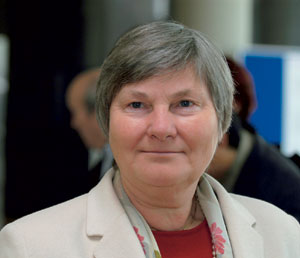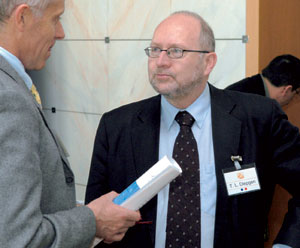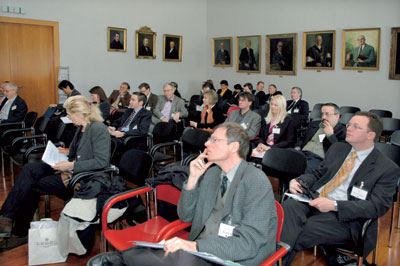

GD — Society for Dermopharmacy
 |
Issue 1 (2006) |
Dermatotherapy
GD-Symposium on Health Economy in Dermatology
Dermatological
Therapy in Times of Health Reform
Report
by Dr. Thomas Müller-Bohn, Süsel
The feasibility of dermatological pharmacotherapy is increasingly limited
by the restrictions of health politics. The saving measures of the Gesundheitsmodernisierungsgesetz
(GMG) (Health Modernization Law) have disproportionately affected patients
suffering from skin diseases. In the scope of 9th Annual Meeting of the
Gesellschaft für Dermopharmazie in Vienna on 14 and 15 March 2005,
for the first time data were published considering one year of experience
with the new regulations. Moreover, the health economic symposium of the
GD department Dermatotherapy dealt with possible consequences of further
health economic alterations to be expected by the new Institut für
Qualität und Wirtschaftlichkeit im Gesundheitswesen (IQWiG) (Institute
for Quality and Cost-effectiveness in Health Service).
Initially, professor Dr. Barbara Sickmüller, Bundesverband der Pharmazeutischen Industrie (BPI) (Federal Association of the Pharmaceutical Industrie), Berlin, compared the expectations to date on the work of the recently founded German institute with the regulation of drug markets in the remaining European area. Corresponding to a survey, clinical and pharmaco-economic data about drugs are compulsorily demanded in 17 EC-countries and in addition in Norway and Switzerland.
They serve
- in Belgium, France, Italy, Latvia, Lithuania, Austria, Switzerland and Slovenia as basis of price formation,
- in Belgium, Estonia, Finland, Greece, Italy, Latvia, Lithuania, the Netherlands, Norway, Austria, Poland, Portugal, Sweden, Switzerland, the Czech Republic and Hungary as regulation of reimbursability,
- in England and Wales as basis for recommendations,
- in additional countries as data to be supplied voluntarily for decisions about reimbursability and price regulation, effectiveness under real conditions.
Many details on the investigation of pharmaco-economic data in particular on the structuring of model calculations are for example handled in a completely different manner in different countries. Usually, a distinction is made between the effectiveness at ideal-typical conditions of clinical studies ("efficacy") and the effectiveness at real ("effectiveness"). The latter can by nature only be observed after the market introduction as it is also dependent from interactions with other drugs and the compliance at everyday conditions.
 Professor Dr. Barbara Sickmüller of the Bundesverband der Pharmazeutischen Industrie (BPI) (Federal Association of the Pharmaceutical Industry) informed about the concepts on cost regulation of drugs in different European countries. Moreover, she critically looked into the planned tasks of the newly - in connection with GMG - established Institut für Qualität und Wirtschaftlichkeit im Gesundheitswesen (IQWiG) (Institute for Quality and Effectiveness in Health Care). |
The Bundesverband der Pharmazeutischen Industrie (BPI) (Federal Association of the Pharmaceutical Industry) considers in the practice-oriented "effectiveness" the criterion which best expresses the interests of the patients however, the comments from the IQWiG rather aim at "efficacy". As this however is already consulted in the approval process on the benefit-risk assessment, the IQWiG is not to repeat this procedure. In lieu more increased effort is to be set on application observations which however yet have to be further developed.
How transparent is IQWiG?
Furthermore, the announced process of IQWiG lacks of transparence. Hence, the regulations concerning the right of hearing for companies concerned and on the necessity of justification for decisions called for in the European Transparency Guideline 89/105/EC are not adhered to in Germany. On the other hand there are arguments on hand that the IQWiG only makes recommendations, the Mutual Federal Commission will however fall back upon the assessment of the IQWiG in his decisions.
 Professor Dr. Matthias Augustin head of a research group Pharmaco-economy and Quality of Life at Hautklinik of the Universitätsklinikum (Dermatological University Clinical Center) Hamburg-Eppendorf, presented results of a long-term analysis on cost effects of the GMG in the field of Dermatotherapy. Moreover, he moderated the symposium which he had organized in his function as head of the department Dermatotherapy of the society. |
Accordingly, the work of the new institute has to be observed considerately. In case of need the pharmaceutical industry will claim the transparency of the proceedings and the clarity of criteria per curiam as this has been the case in a comparable situation three years ago in Austria.
Declining dermatics sales
The foundation of the IQWiG belongs to the long-term consequences of the GMG. Different measures in contrast took effect already shortly after coming into force of the law in the beginning of 2004. The exclusion of OTC-drugs from reimbursability turned out to be of particular relevance for dermatological patients.
Professor Dr. Matthias Augustin, Hamburg, introduced in Vienna for the first time information documenting effects of the new regulations over the period of one entire year. According to that, the overall drug sales 2004 increased by 0.6 percent to 20.2 billion Euro compared to the previous year, however the sales of the ATC-group dermatics decreased in the same period by 8.6 percent to 558.1 million. Thereof only 263.0 million (24.3 percent less compared to the previous year) have been prescribed to the debit of the GKV.
The average sales decline of dermatics amounted to 21.2 percent for dermatologists and 30.1 percent for general practicioners. For prescription dermatics sales receded by 4.6 percent to 195.2 million and for non prescription ones even by 52.5 percent to 67.8 million Euro. Whether a substitution of non-prescription by prescription drugs comes about is subject to intense contestation and not clearly evident from the present data.
Patients suffering
from dermal
diseases particularly strained
All the more distinct are the financial effects on patients. Thus the frequently necessary basic therapy of skin diseases is no longer disbursed by the GKV. Consequently, at large-scale treatment of ichthioses, psoriasis or the atopical eczema - according to the degree of severity -annual costs between 150 and 2,500 Euro accrue which the patient has to bear himself. For an extreme individual case even costs in the amount of 6,300 Euro have been determined.
Following a survey in university ambulances half of the psoriasis patients spend over 600 Euro per year for their basic therapy. Such calculations though only include expenses effected. In contrast, unconsidered are expenses which are medically reasonable or necessary, which are however not undertaken due to the lack of financial means of the patients concerned.
 Ralf Cummerow, member of the working group of professor Augustin at Universitäts-Hautklinik (University Dermatological Clinic), Hamburg, presented the results of a study on the effectivity and cost-effectiveness of a study of Tacalcitol at psoriasis. In April 2005 the physician and certified computer scientist who is equally member of the Gesellschaft für Dermopharmazie has been awarded the "Hermal Förderpreis Dermatologie (Hermal Advancement Award Dermatology" for his work on the subject Pharmaco-economical method study on the capture of patient-related benefit values: Willingness-to-pay, patient preference and quality of life at psoriasis vulgaris". |
In view of the considerable individual burden many patients having only limited means will significantly reduce their basic therapy or even completely refrain from it. This is why Augustin expects the diseases to aggravate in many cases and more expensive drugs will become necessary. Thus the exclusion of OTC-drugs from the reimbursability will not be able to reduce medicament expenses of the GKV in dermatology on long-term.
Detriments of quality of life
Hence, in Augustin's view, an enhanced emphasis should be set on the fact which increased costs and detriments of quality of life come about for patients affected by dermatological diseases. However, as of shortly pharmaco-economic and quality of life research concentrated within dermatology only to few frequent indications.
Only some recent works offer appropriate argumentation material for a large number of skin diseases. Augustin refers to a study by Dr. Ina Zschocke, Hamburg in which the costs accruing for diseases and effects on the quality of life at acne vulgaris, tinea pedis, onychomycosis, verrucae vulgaris and herpes labialis have been investigated. Also here could be shown that the financial charges of patients by the GMG have increased.
Complex study design
The presentations by Dr Andrea Schlöbe and Ralf Cummerow from the working group of professor Augustin point out which differentiated considerations are required for the pharmaco-economic assessment of therapies for skin diseases. Detailed information about the results of clinical and pharmaco-economic studies based on a povidone-iodine complex in a hydrogel base in the scope of a wound therapy presented by Schlöbe is contained in issue 1/2005 of DermoTopics.
 Professor Dr. Thomas L. Diepgen from the department Clinical Social Medicine at the University Clinical Center Heidelberg showed the benefit of dermatological prevention measures and thereby attainable cost savings by means of epidemiological data. Thus for example in the hairdresser trade it was possible to cut the number of occupationally caused dermatoses and the compensatory damages in half within four years by a large-scale skin protection program. |
Cummerow compared the application of Tacalcitol and Calcipotriol at light and semi-severe psoriasis. Accordingly, the costs accruing for the reduction of the PASI-score are 75 percent lower based on Tacalcitol to be applied only once daily compared to the application with Calcipotriol which is to be applied twice daily and ensures a better healing rate. However, this result depends on the presumption of consideration, as became evident in the discussion.
Cost-savings by prevention
Professor Dr. Thomas L. Diepgen, Heidelberg, substantiated the distinct effect of dermatological diseases on the quality of life by means of epidemiological data. Thus a survey among persons at the age of 20 to 60 years revealed that approx. 43 percent of the persons interrogated have suffered from a skin disease requiring treatment in the last 12 months. This high number of persons affected entails, viewed from a macro socially angle - also for non-life threatening diseases - to a high loss of quality of life.
This serves as justification for efforts directed at the prevention of dermatological diseases having also considerable economic effects beyond quality of life as Diepgen shows by the example of occupational skin diseases. They constitute roughly one third of all reported occupational diseases, however, an additional considerable estimated figure of unknown cases is presumed. The public awareness for the significance of occupational dermatoses and their possible prevention is unfortunately not yet very high in comparison to other occupational diseases as dorsum complaint.
 In the scope of its 9th Annual Meeting in Vienna on 14 and 15 March 2005, the Gesellschaft für Dermopharmazie organized for the third time already a symposium on questions of health economy in dermatology. Top priority of the event were effects of the law on modernization of the public health insurance (GMG) on the dermatological pharmaco-therapy coming into effect in 2004. Summaries on all lectures can be found at the internet address www.gd-online.de. |
In Diepgen's view the direct costs originating from occupationally caused skin diseases amount only to one sixth of the overall costs. Considerably higher are the indirect costs for losses of production, occupational retraining and compensatory damages. These costs, therefore, have to taken implicitly in consideration when comparing the costs for prevention measures.
A good example for successful prevention in the sector of occupational dermatoses is the area of the hairdressers' trade. Here, based on the implementation of a set of regulations, effective health pedagogic measures, technical rules for sensitizing substances and a substantial renunciation of glycerol monothioglycolate the number of cases and the amount of compensatory damages has been cut in half from 1994 to 1998.
Also the major success
achieved in the construction sector in Scandinavia has shown that in particular
training on the correct application of skin protection products is decisive
to succeed improvement. In Germany further prevention efforts are at present
directed at nursing care professions.
top